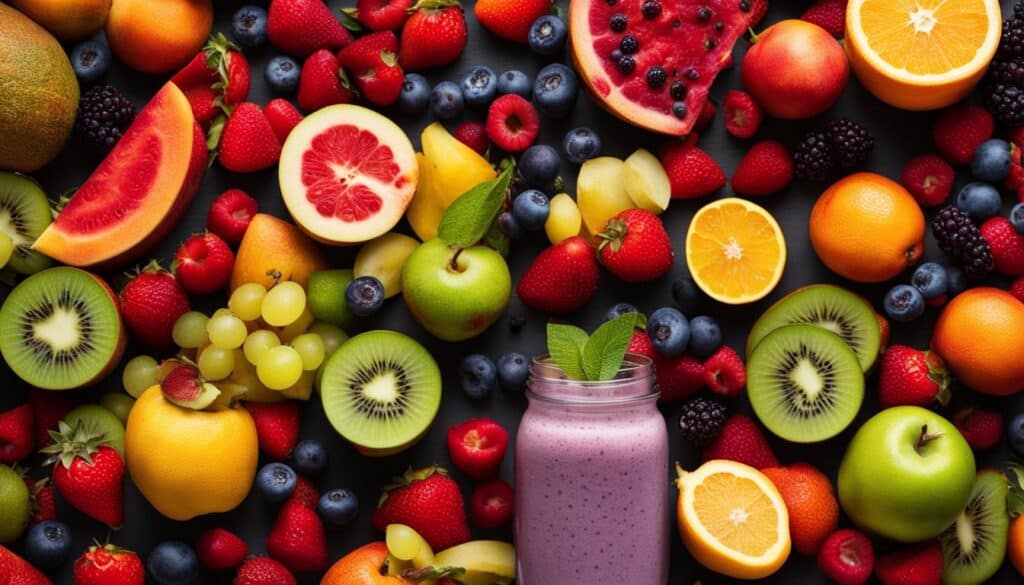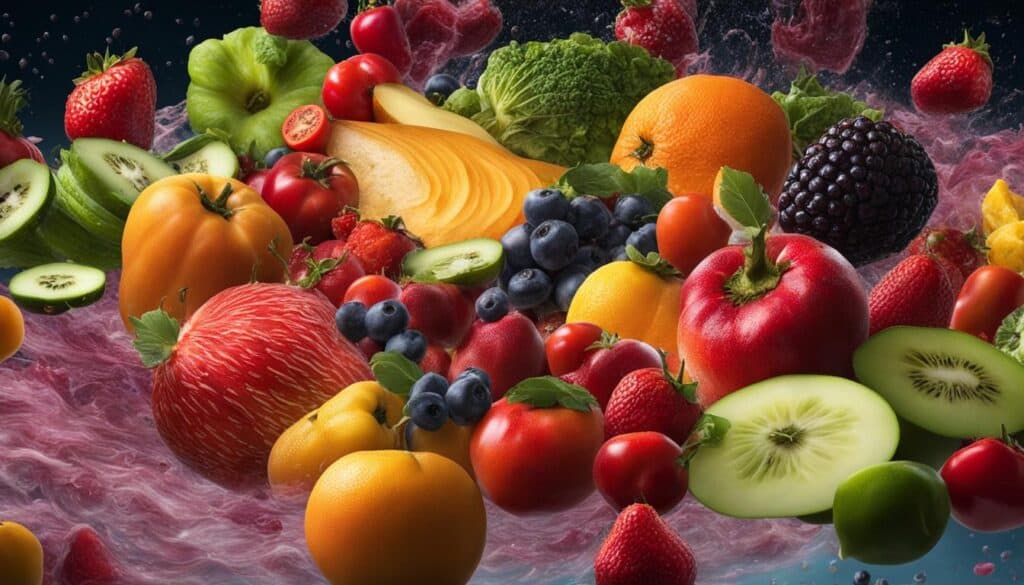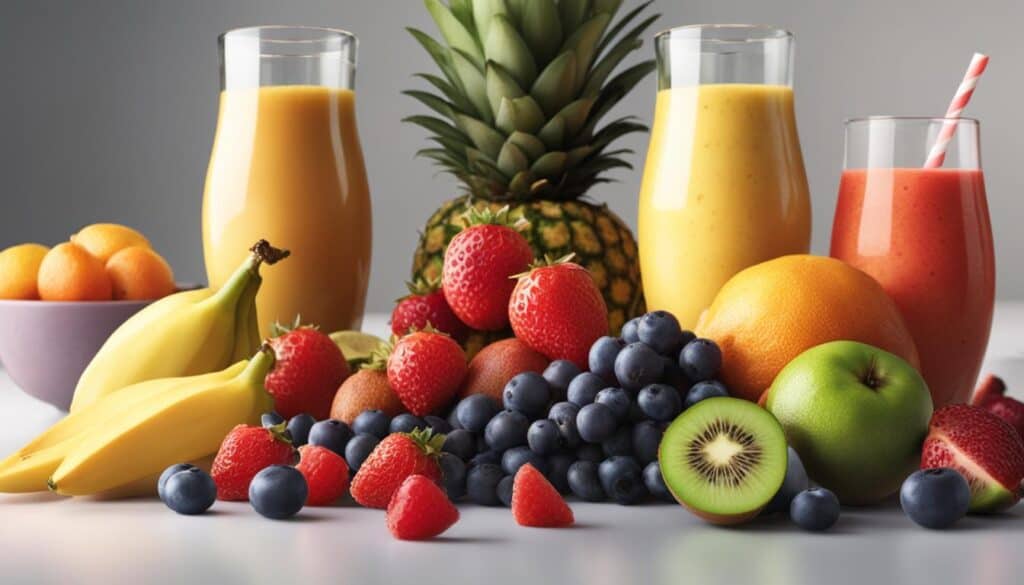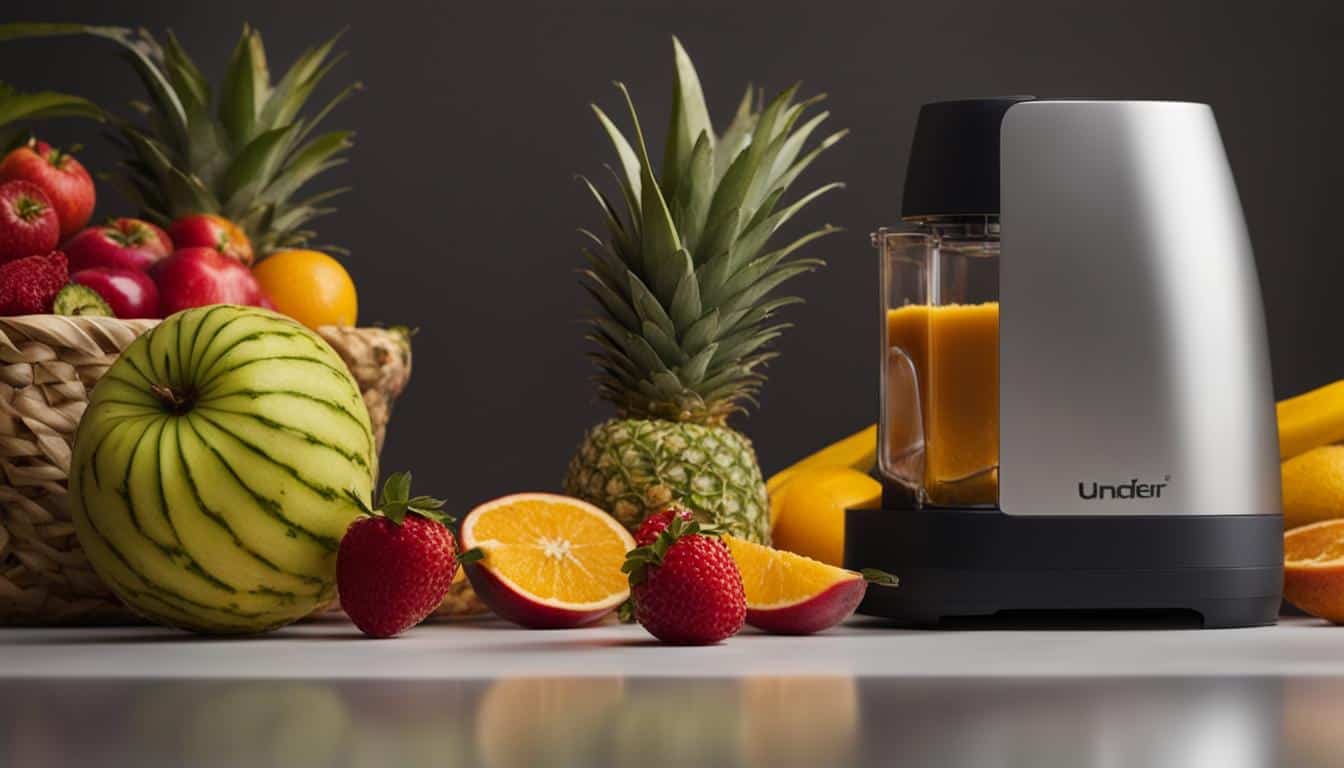When it comes to consuming fruits, there is an ongoing debate: is blending fruit as beneficial as eating it whole? Let’s uncover the truth behind blending fruit versus eating it unprocessed.
Blending fruit and eating it unprocessed are two distinct ways of enjoying the goodness of fruits. While blending fruit into a smoothie may seem convenient and delicious, there are considerations to keep in mind.
A study published in the International Journal of Obesity revealed that participants consumed more calories per day when drinking a blended fruit smoothie compared to eating an equivalent portion of whole fruit. This suggests that blending fruit may be less filling than eating it whole. Another study published in The British Journal of Nutrition found that chewing increases satiety, which could contribute to feeling fuller after consuming the whole fruit. Additionally, blending fruit alters the insoluble fiber present in it, potentially affecting the glycemic index of the food. However, more research is needed to fully understand the impact of blending on nutrient absorption and satiety signals.
Key Takeaways:
- Blending fruit and eating it unprocessed are two different ways of consuming fruits.
- A study suggests that blending fruit may be less filling than eating it whole.
- Chewing increases satiety, potentially leading to feeling fuller after eating the whole fruit.
- Blending fruit changes the insoluble fiber and may affect the food’s glycemic index.
- Further research is needed to understand the impact of blending on nutrient absorption and satiety signals.
The Nutritional Benefits of Blending Fruits
When it comes to consuming fruits, blending them can offer several nutritional benefits. Blending fruits breaks them down into a drinkable form, making it easier for the body to absorb the nutrients. This can be particularly beneficial for individuals with digestive issues or difficulty chewing. Blending also retains the fiber content of the fruits, which is essential for maintaining a healthy digestive system.
To maximize the nutritional benefits of blending fruits, it is recommended to use a variety of fruits. Each fruit brings its own unique set of vitamins, minerals, and antioxidants to the blend, creating a well-rounded nutritional profile. Including the skin and seeds of fruits whenever possible can further enhance the nutritional content of the smoothie. For example, blending berries with their seeds adds an extra dose of fiber and omega-3 fatty acids.
Adding other ingredients like yogurt or nut butter can also enrich the nutritional value of the smoothie. Yogurt provides probiotics and additional protein, while nut butter adds healthy fats and extra flavor. These additions can make the smoothie more filling and satisfying, helping to keep hunger at bay.
| Ingredient | Nutritional Benefits |
|---|---|
| Berries | Rich in antioxidants and fiber |
| Bananas | High in potassium and vitamin B6 |
| Spinach | Packed with iron and folate |
| Yogurt | Provides probiotics and protein |
While blending fruits can offer numerous nutritional benefits, it’s essential to be mindful of the overall calorie and sugar content of the smoothie. Using a moderate amount of fruit and avoiding excessive sweeteners or added sugars is key for maintaining a balanced and healthy diet. Enjoying a blended fruit smoothie as part of a well-rounded meal or snack can be a delicious and convenient way to increase your intake of essential nutrients.
Pro Tips for Blending Fruits
- Experiment with different fruit combinations to find your favorite flavors.
- Include a source of protein, such as Greek yogurt or protein powder, to make the smoothie more filling and nourishing.
- Don’t be afraid to add vegetables like spinach or kale for an extra boost of nutrients.
- Consider adding a small amount of healthy fat, such as nut butter or avocado, to increase the absorption of fat-soluble vitamins.
- Use a high-quality blender to ensure a smooth and creamy texture.
Blending fruits offers a convenient and tasty way to increase your intake of essential nutrients. With a variety of flavors and combinations to choose from, you can create a delicious smoothie that meets your nutritional needs. Just remember to be mindful of the overall calorie and sugar content, and don’t be afraid to get creative with your ingredient choices!
The Health Benefits of Eating Whole Fruits

Eating whole fruits provides numerous advantages for our overall health and well-being. Whole fruits are packed with fiber, essential vitamins, minerals, and antioxidants that support various bodily functions and contribute to disease prevention. Here are some key reasons why eating whole fruits is better than consuming them in other forms:
- Fiber-rich: Whole fruits contain a significant amount of dietary fiber, which plays a crucial role in digestion. Fiber adds bulk to our stools, promoting regular bowel movements and preventing constipation. It also helps maintain healthy cholesterol levels and supports heart health.
- Nutrient-dense: Whole fruits offer a wide array of essential nutrients, including vitamins A, C, and E, potassium, folate, and antioxidants. These nutrients are vital for maintaining a strong immune system, healthy skin, and proper functioning of various organs in our body.
- Blood sugar regulation: The natural sugars present in whole fruits are accompanied by fiber, which slows down the absorption of sugar into the bloodstream. This helps regulate blood sugar levels, reducing the risk of insulin spikes and insulin resistance.
- Feelings of fullness: The fiber content in whole fruits contributes to increased satiety and can help control appetite. This can be especially beneficial for weight management and preventing overeating.
To fully enjoy the health benefits of eating whole fruits, it is best to consume a variety of fruits and include them as part of a balanced diet. Aim to incorporate different colors of fruits, as each color represents a unique set of nutrients. Additionally, it is advisable to eat fruits in their whole form instead of relying solely on juices or blended versions, as the fiber content remains intact in whole fruits.
By prioritizing whole fruits in our diet, we can reap the countless benefits they offer and support our overall health and well-being.
Blending vs Juicing Fruits: What’s the Difference?
Blending and juicing are two popular methods of processing fruits, each offering its own unique benefits and drawbacks. Understanding the difference between the two can help you make informed choices about how you consume fruits.
When you blend fruits, you break them down into a smoothie-like consistency, including the skin and seeds. This method retains the fiber and nutrients of the fruit, making it easier for the body to absorb the goodness. On the other hand, juicing removes the pulp and fiber, leaving behind only the liquid. While this may result in a more concentrated dose of vitamins and minerals, it also removes the fiber that aids digestion and promotes feelings of fullness.
To compare the two methods more comprehensively, here’s a table highlighting the key differences:
| Blending Fruits | Juicing Fruits |
|---|---|
| Retains fiber and nutrients | Removes pulp and fiber |
| Easier absorption of nutrients | Concentrated dose of vitamins and minerals |
| May be less filling | Reduced fiber content impacts digestion and satiety |
Ultimately, whether you choose blending or juicing depends on your personal preference and health goals. If you value the benefits of fiber and prefer a more filling option, blending may be the better choice. If you’re looking for a quick and concentrated nutrient boost, juicing can be a convenient option. Be mindful of portion sizes and consider incorporating a variety of fruits into your diet to reap the full nutritional benefits.
The Impact of Smoothie Size and Frequency on Calories and Sugar
When it comes to smoothies, size and frequency play a significant role in the caloric and sugar content. While smoothies can be a nutritious and convenient way to consume fruits and vegetables, it’s important to be mindful of portion sizes and ingredients to avoid excessive calorie and sugar intake.
Table: Comparing Caloric and Sugar Content of Different Smoothie Sizes
| Smoothie Size | Calories | Sugar (g) |
|---|---|---|
| Small (8 oz) | 150 | 20 |
| Medium (12 oz) | 220 | 30 |
| Large (16 oz) | 300 | 40 |
As seen in the table above, smoothie size directly correlates with calorie and sugar content. Larger-sized smoothies contain more calories and sugar compared to smaller ones. It’s crucial to consider individual nutritional needs and goals when choosing the size of a smoothie.
Quote: “Even homemade smoothies made with only fruits and vegetables can add up to a significant number of calories if consumed in excess.” – Nutritionist Jane Smith
In addition to size, the frequency of consuming smoothies also impacts calorie and sugar intake. While smoothies can be a healthy addition to a balanced diet, consuming them excessively can contribute to weight gain and blood sugar imbalances. It’s important to incorporate a variety of whole foods in the diet and not solely rely on smoothies for nutrition.
To maintain a balanced approach, consider limiting smoothie consumption to a reasonable frequency, such as a few times a week, and ensure that other nutrient-rich foods are included in the diet. By being mindful of smoothie size and frequency, it is possible to enjoy the benefits of these tasty beverages without compromising overall health and wellness.
The Importance of Fiber in Fruit Consumption
Fiber plays a crucial role in fruit consumption, providing numerous health benefits. When it comes to consuming fruit, the fiber content is essential for regulating blood sugar levels, promoting better digestion, and increasing feelings of satiety. The fiber in whole fruits acts as a net, slowing down the absorption of sugar into the bloodstream and preventing spikes in insulin. This is particularly important for individuals with diabetes or those looking to manage their blood sugar levels.
Blending fruit can still retain some fiber, although the blending process breaks it down into smaller particles, potentially impacting its function. The insoluble fiber found in the skin and seeds of fruits is often lost in the blending process, while the soluble fiber remains. Soluble fiber helps to lower cholesterol levels and maintain healthy gut bacteria. It is important to note that different fruits have different fiber contents, so consuming a variety of whole fruits can ensure an adequate intake of both soluble and insoluble fiber.
Consuming fiber-rich fruits in their whole form also contributes to feelings of fullness and aids in weight management. The act of chewing whole fruits stimulates the release of hormones that decrease appetite, leading to a greater sense of satisfaction after a meal. Additionally, the physical process of eating whole fruits takes longer compared to drinking blended fruit smoothies, further contributing to increased satiety.
“Consuming fiber-rich fruits in their whole form contributes to feelings of fullness and aids in weight management.”
The Role of Added Ingredients in Commercial Smoothies

When it comes to commercially prepared smoothies, the addition of extra ingredients can significantly impact their nutritional value. These additional ingredients may include sugars, sweeteners, protein powder, milk, yogurt, and nut butters. While these ingredients may enhance the taste and texture of the smoothie, they can also increase the calorie content. It’s important for consumers to be aware of the potential drawbacks of these added ingredients and make informed choices.
Reading the labels is essential when selecting a commercially prepared smoothie. Look for smoothies with minimal added sugars and whole food ingredients. This ensures that the smoothie provides a good balance of nutrients without excessive calories or added sugars. By prioritizing smoothies that use real fruits and vegetables as the main ingredients, you can make a healthier choice.
“Choosing smoothies with minimal added sugars and whole food ingredients is key to ensuring a nutritious choice.”
One way to have better control over the ingredients in your smoothie is to make it at home. By using a blender or food processor, you can create your own smoothie using fresh fruits, vegetables, and other nutritious ingredients. This allows you to tailor the smoothie to your preferences and dietary needs, avoiding any unnecessary additives that may be found in commercially prepared options.
| Added Ingredients | Nutritional Impact |
|---|---|
| Sugars and sweeteners | Increased calorie content, potential blood sugar spikes |
| Protein powder | Added protein, but may increase calorie content |
| Milk and yogurt | Source of calcium and protein, but may add calories and saturated fat |
| Nut butters | Added healthy fats and protein, but can increase calorie content |
By being mindful of the added ingredients in smoothies, whether store-bought or homemade, you can ensure that you are making a nutritious choice that aligns with your health goals and dietary preferences.
The Science Behind Satiety and Smoothies

When it comes to consuming smoothies, understanding the science behind satiety is crucial. Feeling full and satisfied after a meal or snack is important for maintaining a healthy diet. Satiety, or the feeling of fullness, is influenced by various factors, including the chewing process and the content of the food or drink consumed.
Research suggests that the act of chewing plays a role in increasing satiety. The more we chew, the more our bodies release hormones that decrease appetite, helping us feel more satisfied after a meal. When it comes to smoothies, the blending process eliminates the need for chewing, potentially impacting feelings of fullness. Consuming a blended fruit smoothie may be less filling compared to eating the same fruits whole, as there is less chewing involved.
Additionally, blending fruit can affect the fiber content of the smoothie, which may further impact satiety. Fiber is known to contribute to feelings of fullness, as it slows down the absorption of sugar into the bloodstream. While blending can retain some fiber, the breakdown of the fruit into smaller particles may alter its function. This suggests that consuming whole fruits allows for the full benefits of fiber, promoting better digestion, increased satiety, and better blood sugar control.
“Blending fruit smoothies may be less filling compared to eating the same fruits whole due to the difference in chewing time.”
Overall, it’s important to pay attention to portion sizes and consume smoothies mindfully to ensure satiety and avoid overconsumption. Additionally, including a variety of whole fruits in the diet can provide the full range of nutritional benefits and support overall health. While smoothies can be a convenient and delicious way to incorporate fruits into our diets, it’s essential to be mindful of the factors that influence satiety and make informed choices about how we consume them.
| Factors Influencing Satiety | Effects on Smoothies |
|---|---|
| Chewing | Blending eliminates the need for chewing, potentially reducing satiety. |
| Fiber Content | Blending may affect the fiber content of smoothies, potentially impacting feelings of fullness. |
| Portion Sizes | Mindful consumption and portion control are essential for ensuring satiety and avoiding overconsumption. |
By understanding the science behind satiety and considering these factors, we can make informed decisions about how we consume smoothies and incorporate whole fruits into our diets for optimal health and satisfaction.
The Truth about Commercial Smoothies
There are some misconceptions surrounding commercial smoothies. Many people believe that all smoothies are inherently healthy, but this is not always the case. Commercial smoothies can contain high amounts of sugar, calories, and added ingredients. It’s essential to read the labels and choose smoothies with minimal added sugars and whole food ingredients. Additionally, portion control is crucial, as larger-sized smoothies can contribute to excessive calorie and sugar intake.
When selecting a commercial smoothie, it’s important to be mindful of the ingredients. Some smoothies may contain added sugars, sweeteners, protein powder, milk, yogurt, or nut butters. While these additions can enhance the taste and texture, they can also increase the calorie content. To ensure a healthier option, opt for smoothies with minimal added ingredients or consider making homemade versions to have better control over what goes into the drink.
“Not all smoothies are created equal. It’s important to read the labels and choose smoothies with minimal added sugars and whole food ingredients.”
Size matters when it comes to commercial smoothies. It’s easy to be deceived by the large serving sizes offered, but it’s crucial to be mindful of portion control. Even if a smoothie is made with nutritious ingredients, consuming excessive amounts can lead to a high calorie and sugar intake. It’s recommended to enjoy smoothies as a snack or part of a meal, rather than as a replacement for a balanced diet.
While commercial smoothies can be a convenient and tasty option, it’s important to approach them with caution. Being aware of the potential pitfalls, such as added sugars and large portion sizes, can help make informed choices and enjoy smoothies as part of a healthy lifestyle.
Myths vs. Facts: Debunking Common Misconceptions about Smoothies
- Myth: All smoothies are healthy.
- Fact: Commercial smoothies can contain high amounts of sugar and calories, as well as added ingredients that may not be beneficial for health.
- Myth: Smoothies are a guilt-free meal replacement.
- Fact: While smoothies can be nutritious, excessive portion sizes can contribute to a high calorie and sugar intake.
- Myth: Homemade smoothies are always a better option.
- Fact: Homemade smoothies can be healthier if made with whole food ingredients and minimal added sugars.
By understanding the truth about commercial smoothies and being aware of potential misconceptions, we can make informed choices and enjoy these delicious beverages as part of a balanced diet.
Conclusion
In conclusion, blending fruit and eating it unprocessed both have their pros and cons. Blending fruit can be a convenient way to consume a variety of fruits and retain their fiber content. It also allows for the creation of delicious and nutrient-rich smoothies. However, blending fruit may be less filling compared to eating it whole, potentially leading to higher calorie consumption. It can also impact blood sugar levels due to changes in fiber structure.
On the other hand, eating whole fruits provides the full benefits of fiber, promoting better digestion and satiety. It also reduces the risk of chronic diseases, thanks to the wide range of vitamins, minerals, and antioxidants present in whole fruits. By including a variety of fruits in your diet, you can ensure a well-rounded intake of nutrients and reap the health benefits they offer.
When it comes to choosing between blending fruit and eating it whole, it’s important to consider your personal preferences and health goals. If convenience and variety are important to you, blending fruit can be a great option. However, if you prioritize feeling fuller and maintaining stable blood sugar levels, eating whole fruits may be the better choice.
Ultimately, the key is to strike a balance. Be mindful of portion sizes, read labels when choosing commercial smoothies, and prioritize a balanced diet that includes a variety of whole fruits. By doing so, you can enjoy the health benefits of fruits while finding a method of consumption that works best for you.
FAQ
Are blended fruit smoothies less filling than eating whole fruits?
According to studies, participants consumed more calories per day when drinking a blended fruit smoothie compared to eating a calorically equivalent portion of fruit, suggesting that blending fruit may be less filling than eating it whole. Chewing also increases satiety, which could contribute to feeling fuller after eating the whole fruit.
Do blended fruits retain their nutritional benefits?
When blended, fruits are broken down into a drinkable form, making it easier for the body to absorb the nutrients. Blended fruits also retain the fiber content, which is beneficial for digestion. However, blending can also lead to a higher glycemic index compared to eating whole fruits.
What are the health benefits of eating whole fruits?
Whole fruits are rich in fiber, which aids in digestion and promotes feelings of fullness. They also contain a variety of vitamins, minerals, and antioxidants that support overall health and reduce the risk of chronic diseases.
What is the difference between blending and juicing fruits?
Blending involves breaking down the whole fruit, including the skin and seeds, into a smoothie-like consistency, while juicing removes the pulp and fiber, leaving only the liquid. Blending retains the fiber and nutrients of the fruit, while juicing may contain more concentrated vitamins and minerals but lacks the fiber.
Can smoothies be high in calories and sugar?
Smoothies can be a source of hidden calories and sugar, especially when consumed in large quantities or frequently. Commercial smoothies often contain added sugars, sweeteners, or ingredients that increase the calorie content. It’s important to be mindful of portion sizes and ingredients when consuming smoothies.
What role does fiber play in fruit consumption?
The fiber in whole fruits acts as a net, slowing down the absorption of sugar into the bloodstream, which helps regulate blood sugar levels and prevents spikes in insulin. Blending fruit can still retain some fiber, but the blending process breaks it down into smaller particles, potentially affecting its function.
Do commercial smoothies contain added ingredients that affect their nutritional value?
Yes, commercially prepared smoothies often contain added sugars, sweeteners, protein powder, milk, yogurt, and nut butters. While these additions may enhance the taste and texture, they can also increase the calorie content. It’s important to read the labels and choose smoothies with minimal added ingredients.
Does chewing play a role in satiety when consuming smoothies?
Chewing plays a role in increasing satiety, as more chewing leads to the release of hormones that decrease appetite. Blended fruit smoothies may be less filling compared to eating the same fruits whole due to the difference in chewing time. Pay attention to portion sizes and consume smoothies mindfully to ensure satiety.
Are all smoothies healthy?
Not all smoothies are inherently healthy. Commercial smoothies can contain high amounts of sugar, calories, and added ingredients. It’s essential to read the labels and choose smoothies with minimal added sugars and whole food ingredients. Portion control is also crucial to avoid excessive calorie and sugar intake.
What are the advantages and disadvantages of blending fruit vs eating it unprocessed?
Blending fruit retains the fiber content and makes it easier to consume a variety of fruits, but it may be less filling and impact blood sugar levels. Eating whole fruits provides the full benefits of fiber, promotes better digestion and satiety, and reduces the risk of chronic diseases. It’s important to be mindful of portion sizes and choose a balanced diet that includes a variety of whole fruits.





Leave a Reply